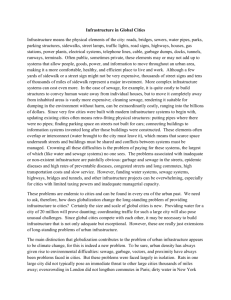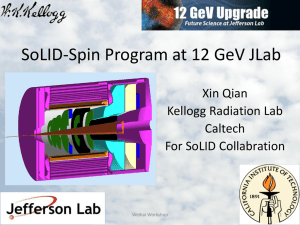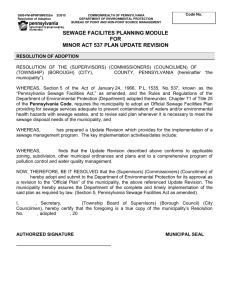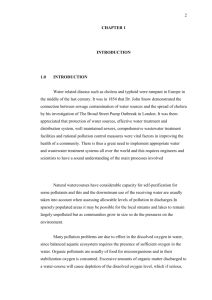51KB
advertisement
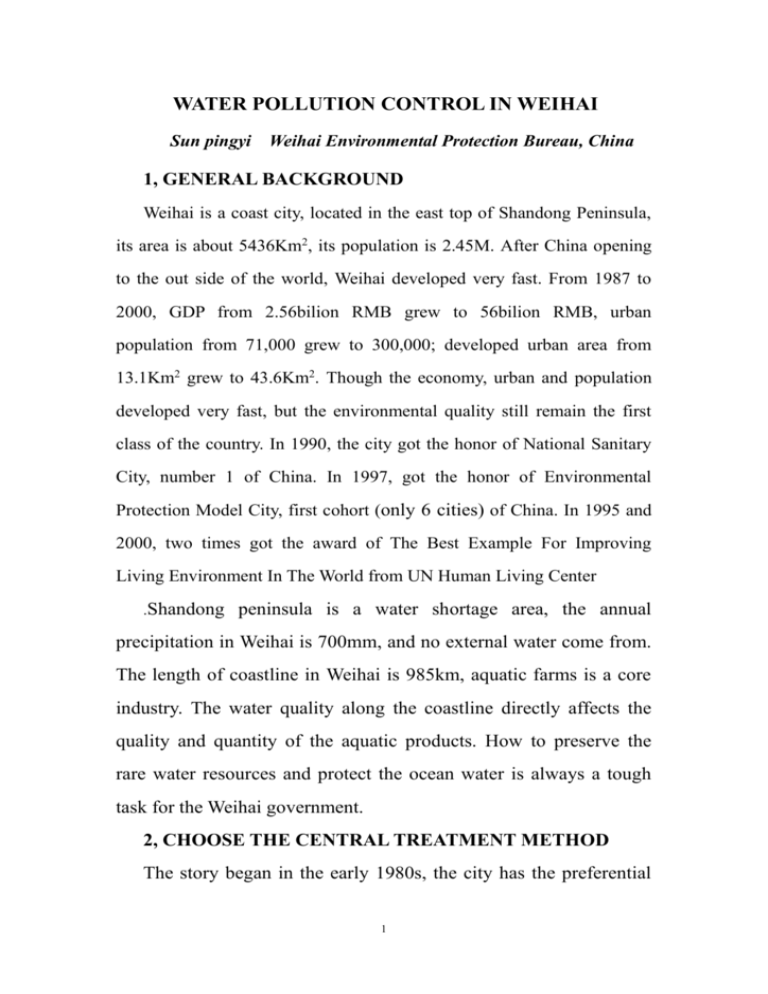
WATER POLLUTION CONTROL IN WEIHAI Sun pingyi Weihai Environmental Protection Bureau, China 1, GENERAL BACKGROUND Weihai is a coast city, located in the east top of Shandong Peninsula, its area is about 5436Km2, its population is 2.45M. After China opening to the out side of the world, Weihai developed very fast. From 1987 to 2000, GDP from 2.56bilion RMB grew to 56bilion RMB, urban population from 71,000 grew to 300,000; developed urban area from 13.1Km2 grew to 43.6Km2. Though the economy, urban and population developed very fast, but the environmental quality still remain the first class of the country. In 1990, the city got the honor of National Sanitary City, number 1 of China. In 1997, got the honor of Environmental Protection Model City, first cohort (only 6 cities) of China. In 1995 and 2000, two times got the award of The Best Example For Improving Living Environment In The World from UN Human Living Center .Shandong peninsula is a water shortage area, the annual precipitation in Weihai is 700mm, and no external water come from. The length of coastline in Weihai is 985km, aquatic farms is a core industry. The water quality along the coastline directly affects the quality and quantity of the aquatic products. How to preserve the rare water resources and protect the ocean water is always a tough task for the Weihai government. 2, CHOOSE THE CENTRAL TREATMENT METHOD The story began in the early 1980s, the city has the preferential 1 policies that the central government offered to the coast opening cities to attract foreign investment. So the economy, the urban construction and population developed very fast. In the same time, the waste water discharged along the coastline grew high, that cause a serious pollution for the ocean water, in some points, COD, OIL can not meet the standard the environmental function zone. How to deal with the problem? At that time, because most of the cities have no sewage treatment plant, according the environmental policies of China, all the factories, hotels must treat their waste water individually, meet the tough standard, then discharge to the environment directly. But because the big investment, high running cost and difficulty administration and inspection for the environmental protection bureau, most of the waste water treatment facilities have not been used properly, they were laid of, ruined out even moved away. According a investigation on the individual waste water treatment facilities conducted by several big cities in 1995, one third of them operating and can meet the discharge standard, one third of them operating but can not meet the discharge standard, another one third of them do not operating at all. In this case, the government of Weihai decided to use the central treatment methods, let the municipal administration bureau construct a sewage treatment plant. Do not demand the factories, hotels to have their own treatment facilities, except factories their waste water does not suitable for the biochemical treatment method, like 2 electroplate plant. All the domestic, service business, and industrial waste water can discharge to the sewage treatment plant, use the secondary treatment method, properly treated, then discharge. The first sewage treatment plant began to operate in 1985, number one in Shandong Province, you also can use your finger to calculate the total number in China at that time. The capacity of the first phase is 5000 tons per day. The second phase is 10,000 tons per day. That began to operate in 1990. The process is primary sedimentation, aeration, second sedimentation, it is a classical secondary treatment method. Its total investment is 12mRMB. The second sewage treatment plant began to operate in 1995, the capacity is 80,000 tons per day, the process is grid chamber, rough screen, fine screen, storage, ocean outfall. We will add the secondary treatment process in proper time. The total investment is 120mRMB. The third sewage treatment plant began to operate in 2000, the capacity of the first phase is 10,000 tons per day, the investment is 50mRMB. The planning capacity is 50,000 tons per day. The process is ORBAL ditch. 3, USE POLLUTER PAY PRINCIPLE, SOLVE THE FINANCIAL PROBLEM These years we have invested so much in the sewage treatment plant construction, where the money comes from? How can we support the running cost? For the first sewage treatment plant, the capital investment totally 3 comes from the government revenue. Because in the early 1980s, China has not accept market economy, still in the central planning economy period, the ownership of the factories, the companies is not the private, stockholders, it is the government, so the government should responsible for the whole things. For the second treatment plant, because at that time, China began its economic reform, accept the market economy gradually. The government of Weihai began to think to use the market mechanism, let the polluter pay the cost. The government established a regulation, all the units that located in the urban area, their waste water must discharge into the urban sewage system, do not demand them to have their own treatment facilities if the waste water can meet the sewage treatment plant receive standard. But the unit must pay the cost. For the capital investment, according the discharge volume, they should pay 700RMB per ton per day once, that a little bit less than the real cost, much less than the individual facility investment. For the running cost, the government only let them to pay 0.15RMB per ton at the beginning. In 2000, the government raised it to 0.2RMB for residents, 0.4RMB for industries. 4, INCREASE THE WATER REUSE RATE, SAVE THE WATER RESOURCES Weihai is a water shortage area, the water resources is only 548 m3 per capital. Water becomes the bottleneck of the development of Weihai. Increase the water reuse rate, not only save the water 3 4 resources, but also reduce the water pollution. In household level, we encourage people to use water saving equipment, change the screw tap to one action tap, big volume urinal to small volume, some householders even storage the water after wash hands or vegetable for running urinal. From this year, using the water saving equipment in household is becoming a law that must be followed from house designing. (3), Spreading the water saving new technology, new process and new equipment. From now, all the new and reform buildings, must use the equipment that can meet the water saving standard. If someone can’t, the administration departments do not permit them to start construction, to accept it put in use, to supply running water. <The note of improving water supplying, saving, and pollution control in urban area, the government of Shandong Province 2001,2> In factories, we do not permit them to establish higher water consumption project, all of them must use clear product process. The water must be recycled, reused as much as possible. A paper mill even take the sewage treatment plant as their water resource, use the treated waste water to produce paper board then package box. Last year the heating-power station invested 50mRMB, change supplying steam to recycle hot water for heating, can save 0.5m ton water every year. Now the water reuse rate in Weihai is 81.4%. 5 In the city’s municipal administration, we encourage people to use the treated waste water to plant trees, irritate the glass land. This year, we invested 30mRMB, constructed a purification plant, it connected to the No1 sewage treatment plant, deeper treat the water discharged from the plant. The process is mixing coacervation substances, sedimentation, sand filter. The quality of the water after treated, can meet the first class of the sewage discharge standard that issued recently. The capacity of the purification plant is 10,000 tons per day, can be widely used for vegetation, industry cooling, road washing etc, that will ease the water shortage very much. Water pricing is an efficient method to solve the water shortage and water pollution problem. During the last two years, Weihai has increase the water price three times, make the water from 0.8RMB to 1.8RMB per ton. We also use the progressive pricing, that means the more water you consumption, the more high of the water price, even can reach 40 yuanRMB per ton. This method not only stimulate public saving water, but also can collect some money to invest in water preservation and development projects. Through the efforts described above, though the population, the industry and discharged waste water increased rapidly, but the environmental quality remain the first class of China. The figures in the tables below show it in detail: 6 Table 1, Some parameters in Weihai urban area Year 1995 1996 1997 1998 1999 2000 Urban populati on (thousan d) Dischar ged Waste 428 462 485 496 508 522 16.00 1723 1925 2347 2437 2119 water(m ton) The rate of industri al waste water meeting standard % 74.17 85.7 80.0 96.4 98.0 98.8 The rate of treated domesti c waste water % The rate of reused industri al water % Per unit GDP water consum ption (ton/mR MB) 17.6 16.1 23.7 47.9 52.1 56.6 74.2 60.8 79.1 58.5 70.1 81.4 2570 1620 1432 1305 1584 1256 The rate of urban water resource s quality meeting standard % 100 100 100 100 100 100 The rate of water function zone quality meeting standard % 100 100 100 100 100 100 Table 2, The sea water quality along Weihai coastline Year PH DO 1996 1997 1998 1999 2000 7.90 7.87 7.91 8.04 8.11 8.19 7.47 6.79 7.03 6.83 Non-orga nic N 0.081 0.053 0.219 0.080 0.160 Non-orga nic P 0.009 0.012 0.034 0.005 0.012 copper Lead oil 0.008 0.004 0.006 0.002 0.006 0.003 0.002 0.003 0.002 0.002 0.100 0.007 0.103 0.047 0.016 5, DISCUSSIONS According the practice in Weihai, using the central treatment method to treat the waste water, there are some aspects need to improve. One is how much the treatment fee should be collected. Generally speaking, the money collected should cover the cost of the treatment. But because China still in the transformation process from planning economy to market economy, the government still subsidizes in some fields, so the money we collected still can’t cover the cost now. Another is using the same treatment fee for the all kind of factories is not fare. Because in some factories the pollutant 7 concentrations are very low, some are very high, the treatment cost per unit is much different. So we should charge them with different fee levels according its waste water concentration. The third is decision–making transparency and public participation. The stakeholders of the water pricing and water treatment fee are all the factories, hotels, resident etc. The government should let them know why? How? Let them participate in the decision- making. Now in China lack the mechanism to encourage the public to participate in the decision making process, sometime the stakeholders doubt the decision made is fare enough, reluctant to pay the money. 8





